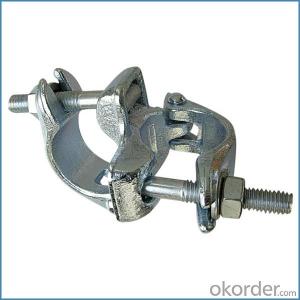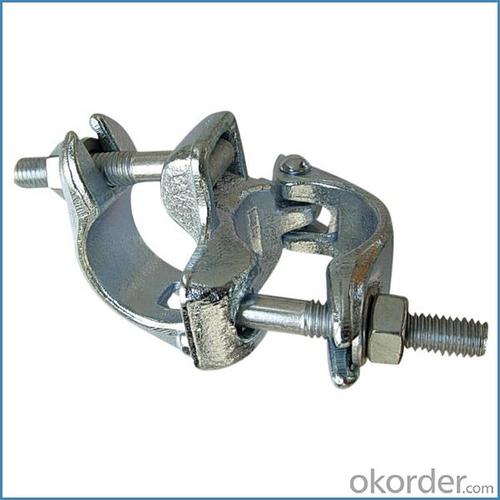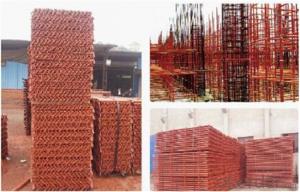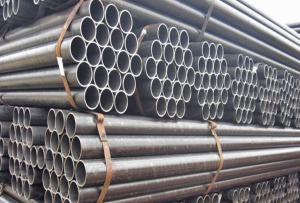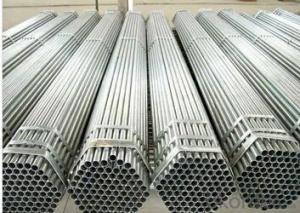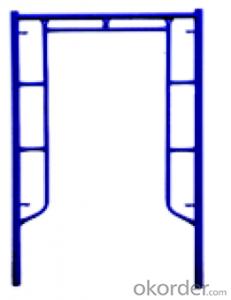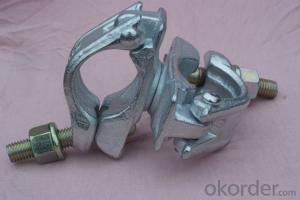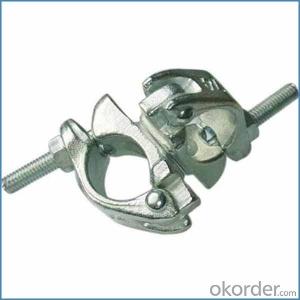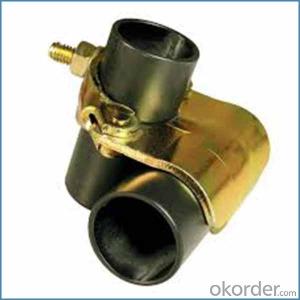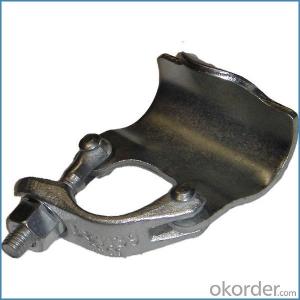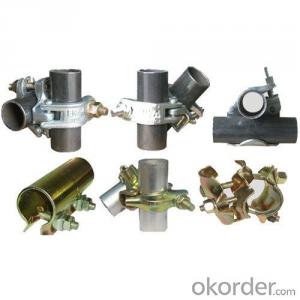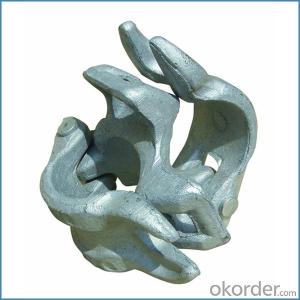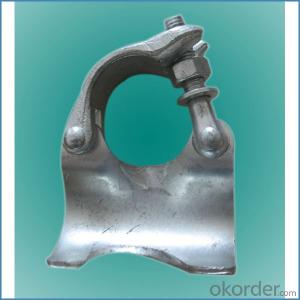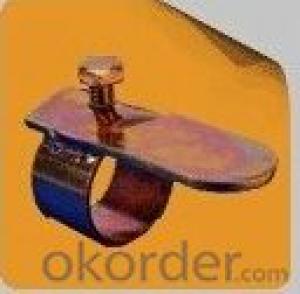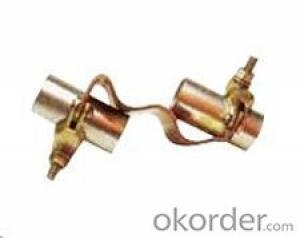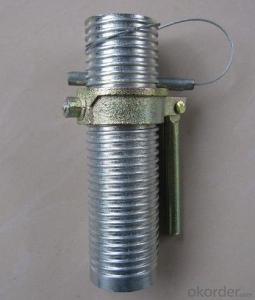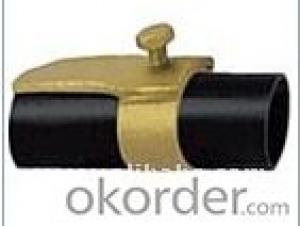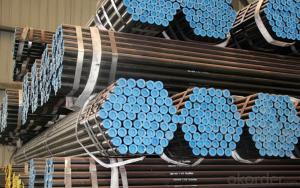Forged Scaffolding Clamp british German Forged Type
- Loading Port:
- Tianjin
- Payment Terms:
- TT OR LC
- Min Order Qty:
- 1000 kg
- Supply Capability:
- 100000 kg/month
OKorder Service Pledge
OKorder Financial Service
You Might Also Like
Forged Scaffolding Clamp british German Forged Type
Description
1.The scaffolding coupler is always used to connect the steel pipe as scaffolding system.
2.The often used coupler is swivel coupler and righ angle coupler .
3.We can provide types of scaffolding coupler according to your requirement.
4.Couoler can fix the 48.3mm scaffolding steel pipe tightly and make the whole scaffolding system more steadily.
Feature
(1)Excellent Anti-Breaking—Cold Pressed Steel
(2)Outstanding Resistance Deformation
(3)Strong Anti-Dropping Ability
Photo
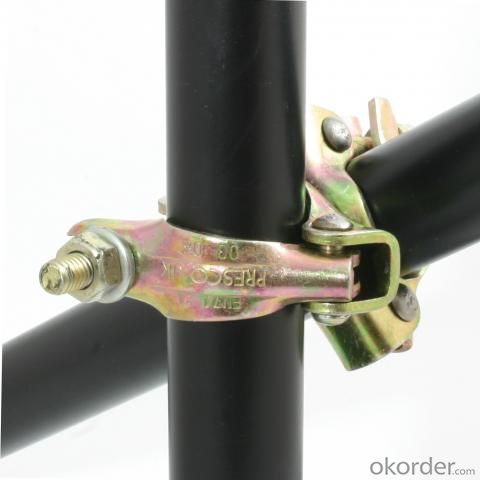
Parameter
| Material | Q235,345steel |
| Size | 48.3mm*48.3mm |
| Surface finish | Galvanized |
| Weight | 1.1kg around |
| Standard | BS1139,EN74 |
| Package | 25pcs/bag,steel pallet |
| Manufacture | As per customer requirement |
| Market | Africa, South America, the Middle East and Asia |
FAQ
Q: Are you a factory or trading company?
We are a state-owned corporation in China,dealing with various kinds of building materials.We have our holding subsidiaries.
Q: Where is your factory located? How can I visit there?
Our factory is located all around China.
Q: Can I get some samples?
Sample is free, customer only pay freight for the first time.
Q: Delivery?
10-30days. (5-15 containers)
Any question,feel free to contact us.
- Q: Can steel tube couplers be used for both standard and custom scaffolding designs?
- Steel tube couplers can be utilized for standard and custom scaffolding designs alike. These couplers are widely used in the construction industry to connect and secure steel tubes in scaffolding structures, showcasing their versatility and popularity. Regardless of whether it is a standard or custom scaffolding design, incorporating steel tube couplers is a simple task. These couplers come in different types, including swivel couplers, sleeve couplers, and putlog couplers, which allow for flexibility in designing scaffolding structures. With the ability to securely join tubes at different angles, complex scaffolding configurations can be created to meet specific project requirements. Moreover, steel tube couplers are highly durable and can withstand heavy loads and adverse weather conditions. They are manufactured to meet industry standards and undergo rigorous testing to ensure their strength and reliability. This makes them suitable for use in both standard and custom scaffolding designs, guaranteeing the stability and safety of the structure regardless of its complexity or uniqueness. To sum up, steel tube couplers are compatible with both standard and custom scaffolding designs. Their versatility, strength, and durability make them a trusted choice for connecting steel tubes in various configurations, providing a secure and stable scaffolding system for construction projects.
- Q: Are steel tube couplers compatible with scaffolding systems using different tube shapes?
- No, steel tube couplers are not compatible with scaffolding systems using different tube shapes. Steel tube couplers are designed specifically for use with steel tubes of a certain shape and size, typically round tubes. They are not designed to work with tubes of different shapes, such as square or rectangular tubes. Using steel tube couplers with different tube shapes can result in an unstable or unsafe scaffolding system. It is important to use the appropriate couplers and components that are specifically designed for the type of scaffolding system being used.
- Q: Can steel tube couplers be used for scaffolding projects that require frequent load testing?
- Yes, steel tube couplers can be used for scaffolding projects that require frequent load testing. Steel tube couplers are commonly used in construction and scaffolding industries to connect steel tubes and provide a secure and rigid connection. They are designed to withstand heavy loads and provide a stable structure for scaffolding systems. When it comes to load testing, steel tube couplers are tested and certified for their load-bearing capacity. This ensures that they can support the intended loads during scaffolding projects. Some couplers are specifically designed for heavy-duty applications and are capable of withstanding even higher loads. In scaffolding projects that require frequent load testing, it is important to ensure that the steel tube couplers used are properly rated and certified for the expected loads. Regular inspections and load tests should be conducted to ensure the safety and integrity of the scaffolding system. This involves applying loads to the scaffolding to verify its strength and stability, as well as checking the condition of the couplers and other components. Overall, steel tube couplers are suitable for scaffolding projects that require frequent load testing, as long as they are properly certified and inspected. It is essential to follow the manufacturer's guidelines and industry standards to ensure the safe and efficient use of steel tube couplers in such projects.
- Q: Can steel tube couplers be used in confined spaces?
- Yes, steel tube couplers can be used in confined spaces. Steel tube couplers are commonly used in construction and are designed to connect and join steel tubes together. They are versatile and can be used in various applications, including confined spaces such as tunnels, underground pipelines, and cramped construction sites. Steel tube couplers are compact and lightweight, making them ideal for use in confined spaces where space is limited. They can be easily maneuvered and installed, allowing for efficient construction in tight areas. Additionally, steel tube couplers have high load-bearing capacities, ensuring the structural integrity and stability of the connected tubes in confined spaces. Furthermore, steel tube couplers are resistant to corrosion and have excellent durability, making them suitable for long-term use in challenging environments. Their strength and reliability make them a reliable choice for confined spaces where safety and performance are crucial. Overall, steel tube couplers are a suitable option for confined spaces due to their compact design, ease of installation, high load-bearing capacity, and durability. However, it is important to consider the specific requirements and regulations of the confined space in question and ensure compliance with safety standards before using steel tube couplers.
- Q: How do steel tube couplers accommodate different tube lengths or extensions in scaffolding systems?
- Steel tube couplers in scaffolding systems can accommodate different tube lengths or extensions by providing a secure and reliable connection between two tubes. These couplers are designed to join tubes together, allowing for the desired extension or length variation. The tight grip and strong hold of the couplers ensure stability and safety in the scaffolding structure, allowing for flexibility in adapting to various heights or configurations.
- Q: Are steel tube couplers compatible with modular scaffolding systems?
- Yes, steel tube couplers are compatible with modular scaffolding systems. Steel tube couplers are commonly used in the construction industry to connect scaffold tubes together and create a secure and stable structure. These couplers are designed to fit standard size scaffold tubes and can be used with various types of scaffolding systems, including modular systems. The use of steel tube couplers allows for flexibility and versatility in constructing scaffolding, as they can be easily attached or removed to create different configurations. Therefore, steel tube couplers are a compatible and reliable option for connecting tubes in modular scaffolding systems.
- Q: Can a steel tube coupler be used to connect different sizes of scaffolding tubes?
- Yes, a steel tube coupler can be used to connect different sizes of scaffolding tubes. The coupler is designed to provide a secure and stable connection between tubes of varying sizes, ensuring the stability and structural integrity of the scaffolding system.
- Q: Can steel tube couplers be used in scaffolding projects with fragile surfaces?
- When working on scaffolding projects with fragile surfaces, it is important to take extra precautions to ensure safety. Steel tube couplers, which provide a secure connection between scaffold tubes, are essential for the stability of the structure. However, fragile surfaces are more susceptible to damage, so specific measures must be taken. One option is to use protective padding or cushions between the steel tube couplers and the fragile surface. This helps distribute weight evenly and reduces the risk of damage. Additionally, using larger base plates or spreader plates under the scaffold feet can further distribute the load and minimize impact. Careful planning and design of the scaffolding system are also crucial. The weight should be evenly distributed, and concentrated loads on the fragile surface should be avoided. Adequate bracing and support should be provided to prevent movement or shifting that could damage the surface. Regular inspections and monitoring of the scaffolding system are important to identify any potential issues or signs of damage. Promptly addressing any stress, movement, or damage is necessary to prevent further harm. In conclusion, while steel tube couplers can be used on scaffolding projects with fragile surfaces, it is essential to take additional precautions such as using protective padding, larger base plates, and careful planning. This will minimize the risk of damage and ensure the safety of the fragile surface.
- Q: Are steel tube couplers suitable for scaffolding applications in extreme weather conditions?
- Yes, steel tube couplers are generally suitable for scaffolding applications in extreme weather conditions. Steel is known for its strength and durability, making it a reliable material for scaffolding systems. Steel tube couplers are designed to securely connect scaffolding tubes, providing stability and support. They are able to withstand high winds, heavy rain, and even extreme temperatures. However, it is important to ensure that the steel tube couplers are properly maintained and regularly inspected for any signs of wear or damage, especially in extreme weather conditions. Additionally, it is essential to follow proper safety guidelines and regulations when using scaffolding in any weather conditions to ensure the safety of workers and the stability of the structure.
- Q: im getting it done
- Top of the ear is a bit tougher than the side (presuming that're the direction you're going), but it's not too bad.
Send your message to us
Forged Scaffolding Clamp british German Forged Type
- Loading Port:
- Tianjin
- Payment Terms:
- TT OR LC
- Min Order Qty:
- 1000 kg
- Supply Capability:
- 100000 kg/month
OKorder Service Pledge
OKorder Financial Service
Similar products
Hot products
Hot Searches
Related keywords
